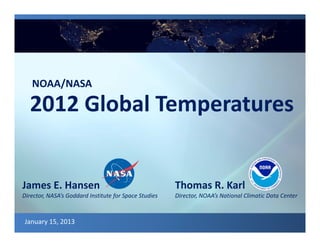719354main noaa nasa climate briefing
•
2 likes•458 views
The document summarizes a report by NASA and NOAA on global temperatures in 2012. It finds that 2012 was the 10th warmest year globally since record keeping began in 1880 according to NASA, and the 9th warmest according to NOAA. All seasons and geographical regions across the globe experienced above-average temperatures for the year. The continental US also had its warmest year on record and experienced widespread drought, according to NOAA.
Report
Share
Report
Share
Download to read offline

Recommended
Recommended
More Related Content
More from Sérgio Sacani
More from Sérgio Sacani (20)
Earliest Galaxies in the JADES Origins Field: Luminosity Function and Cosmic ...

Earliest Galaxies in the JADES Origins Field: Luminosity Function and Cosmic ...
THE IMPORTANCE OF MARTIAN ATMOSPHERE SAMPLE RETURN.

THE IMPORTANCE OF MARTIAN ATMOSPHERE SAMPLE RETURN.
Multi-source connectivity as the driver of solar wind variability in the heli...

Multi-source connectivity as the driver of solar wind variability in the heli...
Gliese 12 b: A Temperate Earth-sized Planet at 12 pc Ideal for Atmospheric Tr...

Gliese 12 b: A Temperate Earth-sized Planet at 12 pc Ideal for Atmospheric Tr...
Gliese 12 b, a temperate Earth-sized planet at 12 parsecs discovered with TES...

Gliese 12 b, a temperate Earth-sized planet at 12 parsecs discovered with TES...
The importance of continents, oceans and plate tectonics for the evolution of...

The importance of continents, oceans and plate tectonics for the evolution of...
A Giant Impact Origin for the First Subduction on Earth

A Giant Impact Origin for the First Subduction on Earth
Climate extremes likely to drive land mammal extinction during next supercont...

Climate extremes likely to drive land mammal extinction during next supercont...
Constraints on Neutrino Natal Kicks from Black-Hole Binary VFTS 243

Constraints on Neutrino Natal Kicks from Black-Hole Binary VFTS 243
Detectability of Solar Panels as a Technosignature

Detectability of Solar Panels as a Technosignature
Jet reorientation in central galaxies of clusters and groups: insights from V...

Jet reorientation in central galaxies of clusters and groups: insights from V...
Extensive Pollution of Uranus and Neptune’s Atmospheres by Upsweep of Icy Mat...

Extensive Pollution of Uranus and Neptune’s Atmospheres by Upsweep of Icy Mat...
Exomoons & Exorings with the Habitable Worlds Observatory I: On the Detection...

Exomoons & Exorings with the Habitable Worlds Observatory I: On the Detection...
Emergent ribozyme behaviors in oxychlorine brines indicate a unique niche for...

Emergent ribozyme behaviors in oxychlorine brines indicate a unique niche for...
Continuum emission from within the plunging region of black hole discs

Continuum emission from within the plunging region of black hole discs
WASP-69b’s Escaping Envelope Is Confined to a Tail Extending at Least 7 Rp

WASP-69b’s Escaping Envelope Is Confined to a Tail Extending at Least 7 Rp
Manganese‐RichSandstonesasanIndicatorofAncientOxic LakeWaterConditionsinGale...

Manganese‐RichSandstonesasanIndicatorofAncientOxic LakeWaterConditionsinGale...
X-rays from a Central “Exhaust Vent” of the Galactic Center Chimney

X-rays from a Central “Exhaust Vent” of the Galactic Center Chimney
Efficient spin-up of Earth System Models usingsequence acceleration

Efficient spin-up of Earth System Models usingsequence acceleration
719354main noaa nasa climate briefing
- 1. NOAA/NASA 2012 Global Temperatures James E. Hansen Thomas R. Karl Director, NASA’s Goddard Institute for Space Studies Director, NOAA’s National Climatic Data Center January 15, 2013 1 January 15, 2013 NOAA/NASA 2012 Global Temperatures
- 2. 2012 Annual Temperature NASA NOAA Anomaly (1951-80 base period): 0.53°C Anomaly (20th Century average): 0.57°C January 15, 2013 NOAA/NASA 2012 Global Temperatures 2
- 3. December 2011 – February 2012 NASA NOAA Anomaly (1951-80 base period): 0.38°C Anomaly (20th Century average): 0.41°C January 15, 2013 NOAA/NASA 2012 Global Temperatures 3
- 4. March – May 2012 NASA NOAA Anomaly (1951-80 base period): 0.56°C Anomaly (20th Century average): 0.61°C January 15, 2013 NOAA/NASA 2012 Global Temperatures 4
- 5. June – August 2012 NASA NOAA Anomaly (1951-80 base period): 0.58°C Anomaly (20th Century average): 0.64°C January 15, 2013 NOAA/NASA 2012 Global Temperatures 5
- 6. September – November 2012 NASA NOAA Anomaly (1951-80 base period): 0.62°C Anomaly (20th Century average): 0.66°C January 15, 2013 NOAA/NASA 2012 Global Temperatures 6
- 7. Northern Hemisphere Land Summer Temperature Anomalies NASA All Stations Limited Stations January 15, 2013 NOAA/NASA 2012 Global Temperatures 7
- 8. Warmest Year on Record for the Continental U.S. NOAA • 3.25F above 20th Century average 2012: 55.32F 1998: 54.32F 2006: 54.30F 1934: 54.13F 1999: 53.93F 1903: 50.74F 1924: 50.63F 1912: 50.34F 1895: 50.54F 1917: 50.11F January 15, 2013 NOAA/NASA 2012 Global Temperatures 8
- 9. U.S. Drought of 2012 NOAA Illinois From MODIS data. Karl et al, 2012 EOS Courtesy of I. Becker-Reshef, E. Vermote, M. Claverie and C. Justice, University of Maryland. 9 January 15, 2013 NOAA/NASA 2012 Global Temperatures 9
- 10. NOAA/NASA Thank you Questions? James E. Hansen Thomas R. Karl Director, NASA’s Goddard Institute for Space Studies Director, NOAA’s National Climatic Data Center January 15, 2013 10 January 15, 2013 NOAA/NASA 2012 Global Temperatures
